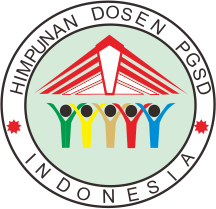Patterns of Teacher Pedagogical Creativity in Cultural Arts and Crafts Subjects in Elementary Schools
DOI:
https://doi.org/10.30595/dinamika.v15i1.16808Keywords:
pedagogical creativity, teacher, arts and culture, elementary schoolAbstract
This research aims to reveal the creativity of teacher pedagogy with creative and participatory learning in provoking the curiosity, activeness and enthusiasm of students. The application of pedagogical creativity as a search or an effective way to develop pedagogical creativity makes it possible to establish that innovative technologies have great potential in developing pedagogical creativity . Method The qualitative method was chosen to explore and give in-depth meaning to the data obtained and to be able to present more meaningful pedagogic creativity research results. Data analysis used descriptive analysis, starting with grouping the same data, then interpretation was carried out to give meaning to each sub-aspect and the relationship between one another. To carry out an analysis or interpretation of all aspects to understand the meaning of the relationship between one aspect and another which is the focus of further research is interpreted or interpreted. development of pedagogical creativity of teachers and students. The research findings show that many challenges to pedagogical creativity in pedagogical practice are manifested in the pattern of: 1) the effective application by a person of the experiences created in new conditions; 2) in repair known according to the new task; in the development of science and development; 3) in the ability to prove intuitive and pre-prepared decisions; 4) in the ability to dream, see near and distant prospects; 6) in the ability to develop ideas and see a series of options in their decisions; 7) to reveal the unknown regularity of previous training and education; 8) in the ability to conduct experiments, deeper research work. Thus, these findings can become the basis for further studies on improving and creating new approaches to the development of pedagogical creativity in the process of arts and culture craft education.
References
[1] A. Zholdasbekov, A. Septemirova, E. Мyrzabekov, Y. Kozybaev, K. Zholdasbekova, and G. Mussabekova, “Pedagogical conditions of formation of creativity at future teachers,” Año , vol. 35, p. 784–805, 2019.
[2] E. Ingleby, "Research methods in education," Professional Development in Education , 2012, doi: 10.1080/19415257.2011.643130.
[3] A. Savoie, “Aesthetic experience and creativity in arts education: Ehrenzweig and the primal syncretistic perception of the child,” Cambridge Journal of Education , vol. 47, no. 1, 2017, doi: 10.1080/0305764X.2015.1102864.
[4] S. Karppinen, A. Poutiainen, S. Kairavuori, S. Rusanen, and K. Komulainen, “Improstory: Social improvisation and storytelling in arts and skills subjects in teacher education,” International Journal of Education and the Arts , vol . 19, no. 9, pp. 1–23, 2018.
[5] E. McWilliam and S. Dawson, “Teaching for creativity: Towards sustainable and replicable pedagogical practice,” Higher Education , vol. 56, no. 6. 2008. doi: 10.1007/s10734-008-9115-7.
[6] V. Vrînceanu, “Pedagogical Creativity in School, as Seen from a Managerial Perspective,” Jun. 2022, doi: 10.5281/ZENODO.6698809.
[7] ZM Yavgildina, GI Batyrshina, IF Kamalova, RI Salakhova, and RF Salakhov, “Pedagogical conditions for the creative self-actualization of future art teachers,” International Journal of Civil Engineering and Technology , vol. 10, no. 2, 2019.
[8] S. Das, Y. Dewhurst, and D. Gray, “A teacher's repertoire: Developing creative pedagogies,” International Journal of Education & the Arts , vol. 12, no. 15, 2011, [Online]. Available: http://www.ijea.org/v12n15/.
[9] D. Sevara, “CREATIVITY AND PROFESSIONAL COMPETENCE-A FACTOR FOR FORMATION OF INNOVATIVE PEDAGOGICAL ACTIVITIES OF FUTURE TEACHERS,” vol. 6, 2021, doi: 10.5281/zenodo.5746513.
[10] A. Harris and L. de Bruin, “An international study of creative pedagogies in practice in secondary schools: Toward a creative ecology,” Journal of Curriculum and Pedagogy , vol. 15, no. 2, 2018, doi: 10.1080/15505170.2018.1457999.
Downloads
Additional Files
Published
How to Cite
Issue
Section
License
Authors who publish with this journal agree to the following terms:
Authors retain copyright and grant the journal right of first publication with the work simultaneously licensed under a Creative Commons Attribution License that allows others to share the work with an acknowledgement of the work's authorship and initial publication in this journal.
Authors are able to enter into separate, additional contractual arrangements for the non-exclusive distribution of the journal's published version of the work (e.g., post it to an institutional repository or publish it in a book), with an acknowledgement of its initial publication in this journal.
Authors are permitted and encouraged to post their work online (e.g., in institutional repositories or on their website) prior to and during the submission process, as it can lead to productive exchanges, as well as earlier and greater citation of published work (See The Effect of Open Access).

Dinamika Jurnal Ilmiah Pendidikan Dasar is licensed under a Creative Commons Attribution 4.0 International License.













